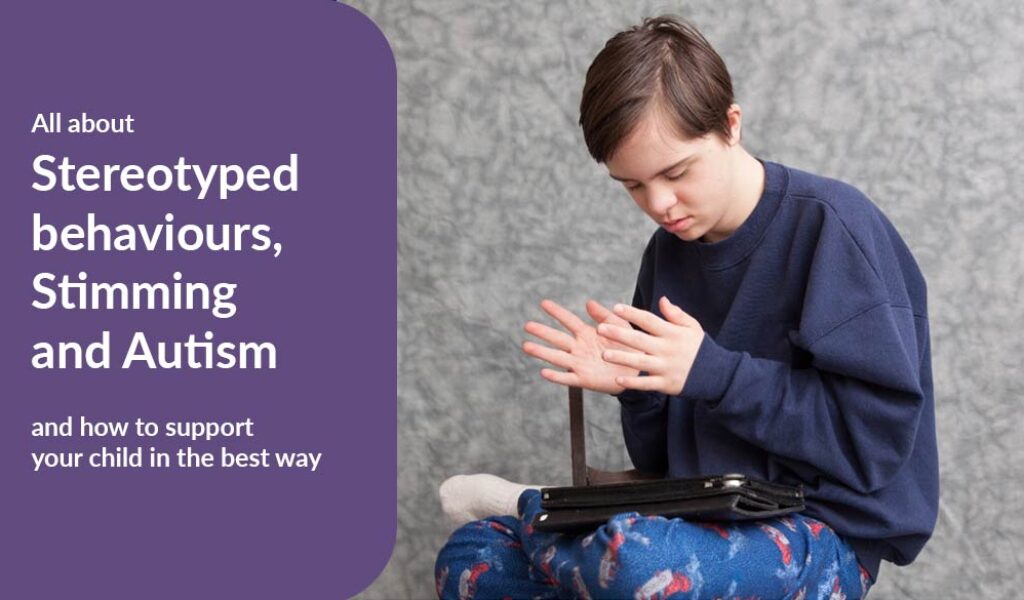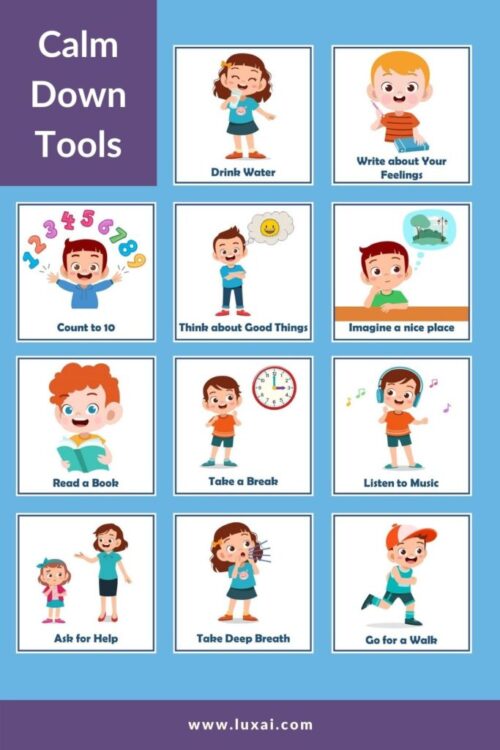Stereotypical behaviours and stimming is very common for people on the autism spectrum. If you are a parent of a child with autism, probably you have seen your child showing some behaviours like hand flapping, rocking, or rubbing their hands. In this blog post, we discuss the most important things you need to know about autism stereotypical behaviours and how to support your child in the best way when they are presenting these repetitive behaviours.
In this blog post, you find answers to:
- What are stereotypical behaviours in autism?
- What are the types of stimming in autism?
- Is stimming a part of an autism diagnosis?
- Why do autistic people stim?
- What are the possible adverse effects of stimming?
- Is stimming dangerous for children with autism?
- Do I need to prevent my child from stimming? Does stimming require any intervention?
- How to manage and reduce stimming in children with autism?
- Why interacting with educational robots reduce stimming and stereotypical behaviours in children with autism?
What are stereotypical behaviors in autism?
Stereotypical or stereotyped behaviors, sometimes also called stimming or self-stimulating behaviors, is a chain of repetitive behaviors, including physical movements, sounds, or words that follow a rhythmic pattern. Not every fidget or repetitive behavior is a ‘stim.’ Generally, you can identify stims if they happen across a range of situations, including when your child is alone.
Stimming is often common in people with autism spectrum disorder (ASD), especially in a variety of emotional situations, such as experiencing anxiety or sometimes joy.
What are the types of stimming in autism?
Stereotypical behaviours in people with autism can have a variety of patterns and shapes. Some children flap their hands, some rock back and forth, some make a specific noise repeatedly or they may rub their hands. The specific feature of these behaviours is that they follow a pattern of repetition, and they are increased when a person is feeling emotions such as anxiety, stress or excitement.

Some examples of stimming behaviours are:
- Flapping hands
- Rocking and bouncing
- Flicking or snapping fingers
- Hair pulling
- Walking on tiptoes and pacing
- Rubbing and scratching the skin
- Licking
- Sniffing
- Stroking objects
- Excessive blinking
- Staring at lights and moving objects
- Repeating words or phrases
- Repeating sounds and noises
- Rearranging objects and obsessions with ordering items in a curtain pattern
Is stimming a part of an autism diagnosis?
Yes. A part of the autism spectrum disorder diagnostic criteria is having restricted and repetitive behaviours that can be presented as repetitive physical movements, use of objects, speech, or sounds.
Why do autistic people stim?
It is not always easy to identify why autistic people stim. Stimming is a mechanism that serves a variety of purposes and it’s hard to choose what is the exact reason for each stimming. However, there are a variety of general reasons why autistic children and adults engage in repetitive and stereotyped behaviours.
Responding to stress, anxiety, and overstimulation:
Many people with autism use stimming and stereotypical behaviours as a self-calming and self-soothing behaviour in response to anxiety. For example, when they are in an environment that is overstimulating for them, such as an environment that is noisy, or too bright, you can see their stimming increase.Responding to uncertainty:
Many autistic people feel more comfortable when their life and task follow a structured way and they know what to expect. Uncertainty will cause them to feel anxiety and stress. In many cases, one of the main causes of increased stimming is being in a situation that is unpredictable or uncertain.Sensory stimulation:
For many people on the autism spectrum stimming is a way to enhance sensory experience. For example, sometimes hand flapping can help them to have a better visual focus or rocking back and forth can provide a better sense of balance.Reducing the impact of unwanted sensory stimulation from the environment:
Sometimes stereotypical behaviours can help an autistic person to focus on one strong sensory stimulation and help them to reduce the impact of other sensory stimulation in the environment, such as loud noise or the challenges of dealing with social situations.Expressing themselves:
In some cases, stimming is used by an autistic person as an unconscious way of expressing their emotions. It can be an expression of their frustration in social communication or their excitement from a wanted situation.Delayed Play Skills:
While stimming may happen because of all the above points, it can also occur at a high rate because toy play or sensory play have not developed for a child. Adding sensory and toy play skills to your child’s routine might give them another outlet for their energy.

What are the possible adverse effects of stimming?
Hindering learning ability:
Since stimming and stereotypical behaviour often indicate anxiety, when a child is involved in showing these repetitive behaviour patterns, we can imagine that they are not fully ready to engage with learning. Stimming and anxiety can reduce the child’s chance to focus and their ability to engage in an activity that needs concentration. Therefore, stimming can reduce the learning opportunity in a child with autism.Increasing the chance of self-harm while engaged in stereotypical behaviours:
Some behaviours such as head banging, biting, or picking the skin can be harmful and can put the child at the risk of injury. If such behaviours exist, it is best to get support from a professional as soon as possible.Difficulty in social interaction and communication:
Sometimes an excessive amount of stimming can distract others and can prevent them from having a meaningful interaction and communication with the autistic person demonstrating these stereotypical behaviours. In more severe cases, this can lead to social isolation in children with autism. In worst case, it can lead to many mental health issues that are the consequence of being isolated or even teased in environments such as the school.School exclusion:
In some cases, excessive amount of stimming and disruptive behaviours can hinder the ability of other kids in the classroom to focus and it may lead to the autistic child being excluded from the classroom and the collaborative learning environments.
Is stimming dangerous for children with autism?
Stimming as explained above is often a behaviour that is self-soothing. In many cases, stimming is an expression that shows the child is experiencing a feeling such as anxiety or they are under a certain level of sensory overstimulation.
Many autistic people do not suffer negative effects of stimming and do not regard it as a negative experience. Some children, however, may need support to change behaviour if stimming becomes compulsive, or if their stims involve a risk of injury.

When can stimming be dangerous?
Any action such as scratching or picking which breaks the skin may pose infection and pain risks. Also any physical aggression (head banging, punching, or biting) towards oneself, poses a risk of injury. Some actions create a risk because a child engages in the behavior for prolonged periods, for example itching one particular spot on the skin.
Some examples of dangerous repetitive behaviors are:
- head-banging
- biting
- punching
- excessive rubbing or scratching at skin
- picking at sores
- swallowing dangerous items
Do I need to prevent my child from stimming? Does stimming require any intervention?
Not always! Normally, stimming itself doesn’t need to be stopped and it doesn’t need any specific intervention. However, since stimming can show that a child is having anxiety and stress or in some cases it may lead to adverse effects, it is important to know when you need to get a professional opinion about your child’s stimming and if it requires any behaviour management intervention.
You can answer the questions below to evaluate if the stimming needs to be professionally assessed and if your child needs support for their stimming:
- Is there a risk of self-harm or self-injury when my child is stimming?
- Does stimming prevent my child from learning?
- Is stimming socially isolating my child?
- Does stimming cause problems for other family members or my child’s classmates?
- Is stimming causing disruption in my child’s classroom?
If there is a risk of self-harm and self-injury, we need to make sure the child is safe. We also need to quickly get professional advice on how to deal with the behaviour that can lead to injury.
By paying attention to the pattern of their stimming, you can learn if they are nervous, and you can help to eliminate or reduce their anxiety.
Furthermore, an increased level of stimming can be a precursor of a more severe emotional and sensory situations such as a meltdown that is about to happen. By being aware of this increased stimming, we can have a good chance of supporting our child to get out of the overstimulating environment or situation, before a full meltdown happens.
How to manage and reduce stimming in children with autism?
Helping a child to manage their own stimming requires the adults and the child to answer two important questions.
- Is stimming in response to anxiety, stress, or frustration, or not?
- Is stimming causing some adverse challenges, such as reducing the ability to focus, creating a chance for self-harm, or distracting others in the environment?
If the answer to any of these questions is yes, we need to consider ways to help the child to learn how to manage their stimming and replace stimming with a more appropriate response and behavior. The goal is to help the child to reduce the stimming that is caused by anxiety and only remain with a type of stimming that is pleasant and joyful for them.
Not every stimming need control and reduction!
Stimming means self-stimulating behaviours. In many cases, it is a calming and enjoyable behaviour for children and adults with autism.
How to identify the reasons behind the stimming?
The first important point in successfully managing and changing stimming in children with autism is to identify the reason behind their stimming or stereotyped behaviour. It is important to learn what are their triggers and possibly to tell different stims apart based on their cause.
When your child’s stimming starts or increases, ask yourself, what has changed? What is triggering their behaviour?
When you know what their trigger for stimming is:
- Try to eliminate or reduce their source of anxiety and discomfort
- If the stimming is caused by stress, try to help them to practice calm down strategies and help them to learn emotion regulation skills. This way they can replace stimming with strategies that can help them to regulate their anger, frustration or anxiety.
- Emotional awareness is a building block for emotion regulation. Help your child to have better emotional awareness and understanding using these activities on emotion recognition and emotion understanding.
- If the stimming is caused by a change of routine or unpredictability, try to stick to a routine and help them to get prepared when there is a change in their daily schedule.
- Try to teach alternative and more positive self-control and self-soothing behaviours, to gradually reduce the stimming with that behaviour. They can try to squeeze a stress ball for example instead of biting their nails or scratching and peeling their skin.
- Try to improve the child’s ability to communicate and use of language.
An important note!
Never show a negative response to a child that is stimming. Showing any sign of anger or frustration to your child can trigger more stress and anxiety in them and more anxiety means more stimming. Your patience and calmness can help them and can reduce their anxiety and therefore their stimming.
Why interacting with educational robots reduce stimming and stereotypical behaviours in children with autism?
Scientific studies and empirical use of robots for autism education show that when autistic children are engaged in an activity with an educational robot, they have significantly less stereotypical behaviours and the behaviours are less intense, compared to the time that they are engaged with a human caregiver. This can show that robots can improve children’s learning opportunity by reducing the anxiety and overstimulation of children during the educational sessions.
This reduced level of anxiety and stereotypical behaviours is mainly because of the nature of the interaction with a robot. An educational robot is generally very predictable, consistent, and easy to understand. This can help children with autism to feel safe and comfortable to interact with the educational robot when they can predict the stable pattern of behaviours and the robot’s responses.
Also, because an educational interaction with a robot is not socially demanding or judgemental, autistic children can practice skills that are more challenging for them, such as social skills or emotional skills, since they know that the robot is not going to judge their responses or get frustrated or disappointed when they give a wrong answer.
Learn more about how QTrobot improves learning in children with autism





